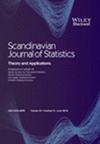Design for order‐of‐addition experiments with two‐level components
IF 1
4区 数学
Q3 STATISTICS & PROBABILITY
引用次数: 1
Abstract
The statistical design for order‐of‐addition (OofA) experiments has received much recent interest as its potential in determining the optimal sequence of multiple components, for example, the optimal sequence of drug administration for disease treatment. The traditional OofA experiments focus mainly on the sequence effects of components, i.e., the experimenters fix the factor level of each component and observe how the response is affected by varying the sequences of components. However, the components may also have factorial effects in that changing their factor levels in a given sequence can affect the response. In view of this, we consider the design problem for OofA experiments where each component is experimented at two levels. A systematic method is given to construct OofA designs that jointly considers the sequence design and factorial design for all components. By appropriately choosing the sequence and factorial designs, we show that the combination of the two parts results in a balanced design with an economical run size. Moreover, the constructed designs enjoy a number of optimality properties such as D‐, A‐ and E‐optimalities under some empirical models. The design method proposed can be extended to some other practical situations like the number of process variables is different from the number of components, and OofA experiments with multi‐level components.This article is protected by copyright. All rights reserved.设计的顺序加法实验与两个水平的组件
排序加法(OofA)实验的统计设计最近因其在确定多组分的最佳序列方面的潜力而受到广泛关注,例如,疾病治疗的药物给药的最佳顺序。传统的OofA实验主要关注成分的序列效应,即实验者固定每个成分的因子水平,观察不同成分序列对响应的影响。然而,这些成分也可能具有因子效应,即在给定的顺序中改变它们的因子水平可以影响反应。鉴于此,我们考虑OofA实验的设计问题,其中每个组件在两个层次上进行实验。给出了一种系统的构造面向对象结构设计的方法,该方法综合考虑了各组成部分的序列设计和析因设计。通过适当地选择序列和析因设计,我们表明,这两个部分的组合导致一个平衡的设计与经济运行规模。此外,在一些经验模型下,构建的设计具有D‐、a‐和E‐最优性。所提出的设计方法可以推广到工艺变量数与构件数不同的实际情况,以及多层次构件的OofA实验。这篇文章受版权保护。版权所有。
本文章由计算机程序翻译,如有差异,请以英文原文为准。
求助全文
约1分钟内获得全文
求助全文
来源期刊

Scandinavian Journal of Statistics
数学-统计学与概率论
CiteScore
1.80
自引率
0.00%
发文量
61
审稿时长
6-12 weeks
期刊介绍:
The Scandinavian Journal of Statistics is internationally recognised as one of the leading statistical journals in the world. It was founded in 1974 by four Scandinavian statistical societies. Today more than eighty per cent of the manuscripts are submitted from outside Scandinavia.
It is an international journal devoted to reporting significant and innovative original contributions to statistical methodology, both theory and applications.
The journal specializes in statistical modelling showing particular appreciation of the underlying substantive research problems.
The emergence of specialized methods for analysing longitudinal and spatial data is just one example of an area of important methodological development in which the Scandinavian Journal of Statistics has a particular niche.
 求助内容:
求助内容: 应助结果提醒方式:
应助结果提醒方式:


